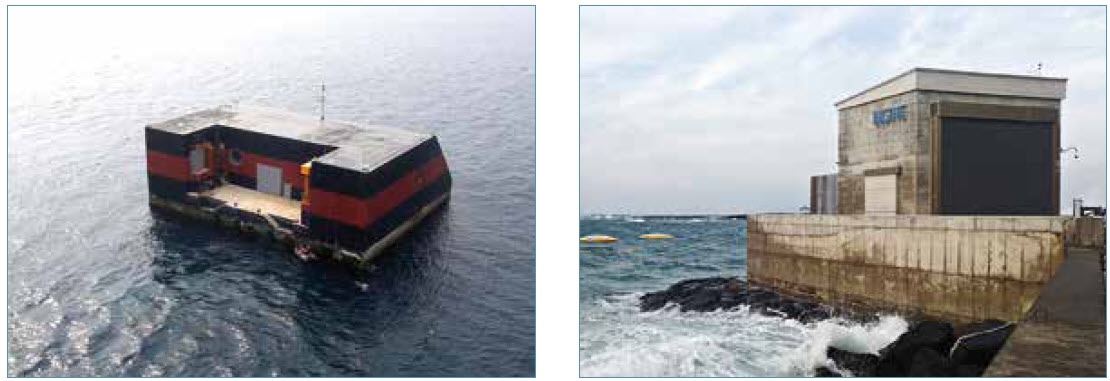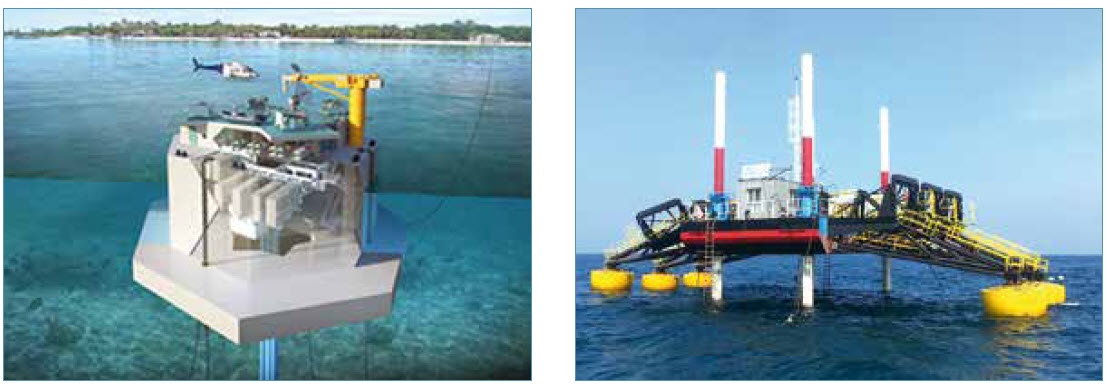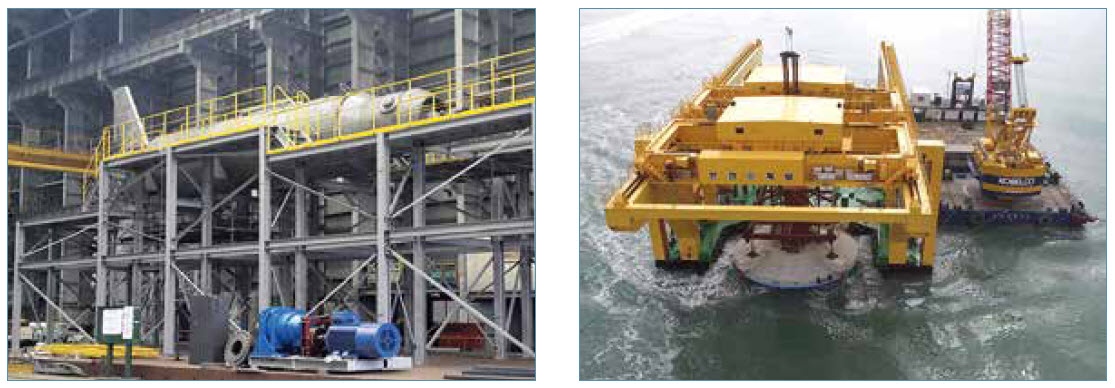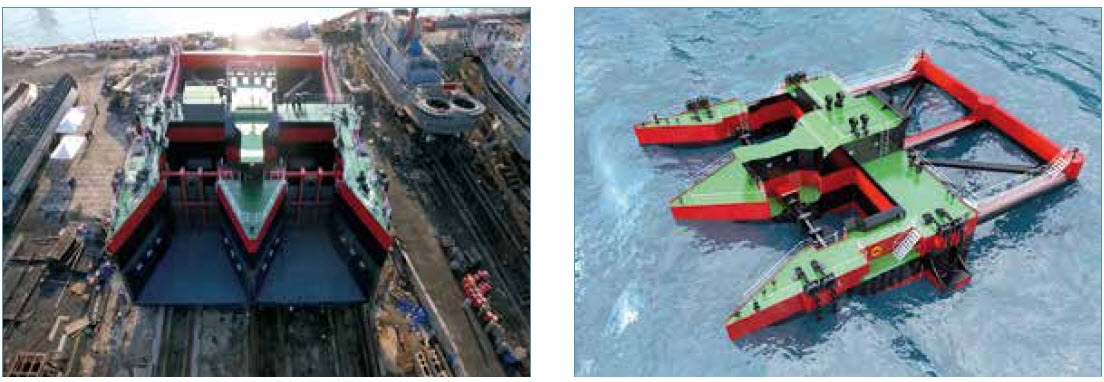REPUBLIC OF KOREA
OPEN SEA TEST SITES
MOF has been supporting construction projects of the open sea test bed for wave energy converters and tidal energy converters, respectively. The construction project for the wave energy converter started in May 2016. The western shore of Jeju Island was selected as the test site, where the Yongsoo OWC wave energy plant is installed nearby and utilized as the offshore substation. The project is expected to be finished by December 2019. Korea Research Institute of Ships & Ocean engineering (KRISO) has been in charge of developing the project. A number of cables from five different berths will be connected to the offshore substation and the grid system with the allowance capacity of 5 MW. The Floating Pendulum Wave Energy Converter (FPWEC), with the capacity of 300 KW, is expected to be tested in the fourth berth, with the water depth of 40 m, in 2017.
The construction project for the tidal wave energy converter, started at the end of 2016, is planning to build the open sea test bed with 5 berths of 4.5 MW grid-connected capacity, from May 2017 to December 2021. Furthermore, the performance test facility for components of tidal energy converters, such as blade and drive train, will be constructed in the project.
OPERATIONAL PROJECTS
500 kW Yongsoo OWC Pilot Plant
The construction of the Yongsoo OWC pilot plant was completed in July 2016 and installed at 1.5 km away from the coastline of Jeju Island. The plant, equipped with impulse turbines and 250 kW generators, and grid-connected by the 22.9 KV AC underwater cable, is currently under the trial run. By analysing the early performance data from the trial run, the maximum efficiency for the OWC chamber, the turbine and the generator turned out to be equal to 52.7%, 40.0% and 91.7%, respectively.
INWave Onshore-Based WEC Plant
INWave™, developed by INGINE, is the onshore-based WEC whose key equipment is installed on land and the energy-absorbing unit is placed on water in close proximity to shoreline. This system holds economic feasibility as it does not require the undersea cable even in a small scale. Furthermore, it maximises the efficiency in shallow waters, by collecting the wave energy from multiple directions. Since the installation of its first 135 KW pilot plant on Jeju Island in late 2015, the plant has been in operation, connected to the power grid.

500 kW Yongsoo OWC plant NWave onshore-based WEC plant
SUPRC 20 kW OTEC and 200 kW HOTEC Plants
Currently, the 20 KW OTEC and 200 KW HOTEC plants are in operation and conducting the performance test at the Sea Water Utilization Plant Research Centre, SUPRC, in Gangwon-do Goseoung-gun, a subsidiary research centre of KRISO dedicated to the deep-sea water application. The 20 kW OTEC plant uses 5ºC of deep-sea water as a heat sink and 26ºC of surface seawater as a heat source, and it exhibits the efficiency of 2.1%. While the 200 kW HOTEC plant also uses 5ºC deep sea water as heat sink, it utilizes readily available thermal energy resources like geothermal energy near the coast, waste heat from ships, woodchip gasification, and other types of nearby power plants to increase the heat source temperature up to 75ºC which exhibits the efficiency of 7.7%. Currently, KRISO is preparing to conduct a demonstration experiment to verify the validity of the thermal energy from 500Kw woodchip gasification plant for 200 kW HOTEC plant.
Heaving Semi-Spheres with Hinged Arm WEC Platform (Hwa Jin Co.)
The “30KW Heaving Semi-spheres with Hinged Arm WEC Platform” project was successfully concluded in 2016. This project has been developed by Hwa Jin Co. and funded by MOTIE. The project aimed to undertake a device development of a Jack-up type WEC platform with Hydraulic PTO system. The prototype has installed near Hupo-hang in the East Sea.

Offshore 1 MW OTEC (left) , Heaving semi-sphere WEC with hinged arm (right)
PLANNED DEPLOYMENTS
Active-controlled Tidal Current Power Generation System
The project is aimed to develop and demonstrate the active-controlled, high efficiency and low cost 200 KW Tidal Energy Converter (TEC), with the operating capacity applicable to the shallow sea conditions (>20 m/s). The TEC was manufactured and its substructure was deployed by KIOST and HDEC in 2016. The remaining part of TEC is planned to be deployed in 2017 followed by performance demonstration of TEC between 2017 and 2018.

200 kW active-controlled tidal energy converter in fabrication and installation of its substructure
Floating Pendulum Wave Energy Converter
Since 2012, the development project for the 300 KW wave energy converter has been carried out by KRISO with the support from MOF. In 2016, the construction of Floating Pendulum Wave Energy Converter (FPWEC), featured with a pendulum activated, high efficiency and high persistence rotary-vane hydraulic pump was completed and deployed to its operation site, waiting to be prepared for the sea test site. The FPWEC is planned to be tested at the open sea WEC test centre of Jeju in 2018.

Construction of 300 kW floating pendulum WEC
SUPRC 1MW OTEC
For the commercialization phase of the OTEC development, KRISO is in charge of manufacturing 1 MW OTEC demonstration plant. The plan is to complete the construction and perform the short-term operation in the east coast of South Korea by 2018, followed by transferring and conducting long-term operation in Tarawa, Kiribati, in 2019. In 2016, KRISO manufactured the 1.2 MW turbine generator, and investigated the external environmental force of the plant site in TARAWA for intake pipe installation. Furthermore, the Environment Impact Assessment (EIA) was conducted for 1 MW OTEC plant. Based on the result of 1 MW OTEC plant operation in Tarawa, KRISO is planning to design and receive the Development Approval (DA) for the marine 1 MW OTEC plant and the AIP for the 10 MW OTEC plant.



